A “normal” lens is one with a focal length about equal to the diagonal size of its film or sensor format, so it makes sense that Pentax APS-C users would want a great 28mm -- it is an exact “normal” lens for us (the sensor diagonals for the K-7 and K-5, for example, are 28.1 and 28.4 respectively).
Many believe the best lens near that focal length is the Pentax FA31 Limited. I was saving to buy it, but since it costs twice as much as I wanted to spend, I also kept researching alternatives. The Contax-Zeiss Distagon T* 28mm f2.8 lens jumped in the running after reading several positive reviews and learning it can be acquired on Ebay for $250 to $400. While the Zeiss 28 requires a Leitax adapter costing another $100, it still comes in for about half the price of the Pentax FA31 Limited and so would be a real bargain if it could match the IQ of the Pentax.
I decided to give the Zeiss a try, and managed to land one from Ebay in mint condition for $385. The first quick shot in lovely late afternoon light had me extoling, “wow, nice lens”:

Of course, I couldn’t just be happy with my find, be grateful for favors from the universe (or whatever). No, I fretted about what I might be missing by choosing the Zeiss over the FA31; obviously auto focus and electronic aperture control, but then for me optical quality trumps all other mere conveniences (and I’m always turning AF off anyway).
Then I saw a review of the Contax-Zeiss 28 f2.8 here at PF by Interested Observer, (Gordon) who also happens to own the FA31 (check out the second post in this thread for his thoughts). I wrote to ask him to do a comparison between the two lenses, but he thought pictures taken where I live -- Northern California wine country, Pacific ocean vicinity -- would make for a better test than in sweltering Arizona where he resides. Next thing I know he’s sent me his FA31 to compare to my Zeiss, and we’d agreed to collaborate on a shootout between the two lenses.
The “shootout” entails simply using the lenses on the same scenes and posting results here, analyzing how pictures compare in color rendering, performance in different lighting conditions, corner-center resolution, chromatic aberration, etc., and then a few final thoughts in this and Gordon’s follow up post. The camera used was a K-7, and all but the token bokeh comparison (done wide open) were shot at f5.6 because the charts I saw seemed to indicate that’s where the best overall resolution was from edge to edge. All pictures were adjusted slightly, and equally, in Lightroom for loss of focus when converting to JPEG, and for the fact that I underexpose when I shoot by 2/3 stops to keep from blowing highlights.
Without further ado -- the first comparison shots; to my eyes they seemed to indicate the lenses were very close in image quality:
Zeiss
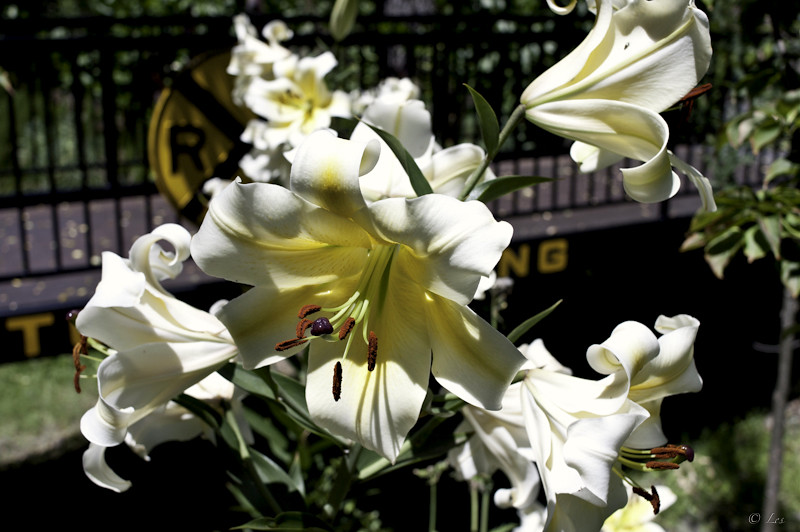
Pentax
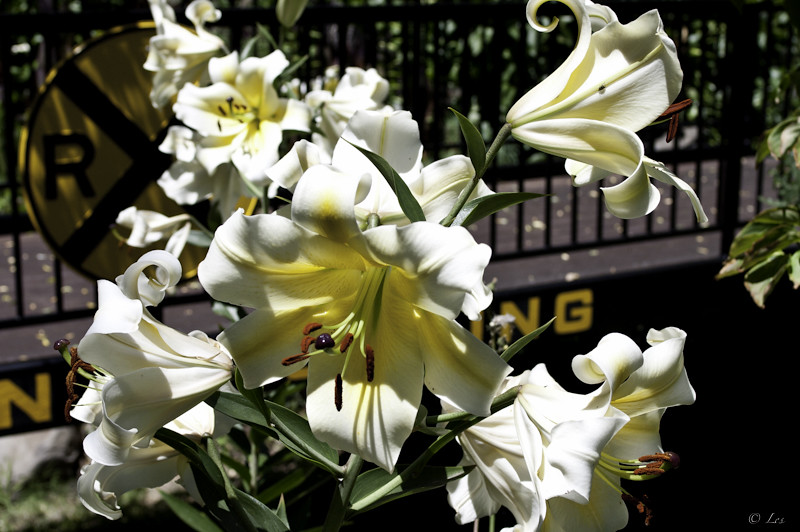
For some reason (a senior moment?) I focused on the center flower’s stamens-pistil area with the Zeiss, but with the Pentax I focused on the stamens-pistil of the flower on the lower right side (which is why the leaves on the same plane in the background of the Pentax shot are also in focus). If you compare sharpness between pictures on the in-focus flowers, there are no noticeable distinctions.
Something the pictures do show is the difference 3mm can make in the neighborhood of 28mm focal length. Comparing the lettering in the background, you can see how much the Pentax compressed that area. In the vineyard shots below, where I moved the camera forward or back to try to create similar fields of view for the lenses, I was surprised to have to move 12-15 feet to achieve that.
Getting back to lens IQ, could these lenses really be so similar? Another pair of shots to see how they handled bright colors seemed to say yes (taken at an “old hippie” tie dye hole-in-the-wall shop in the tiny town of Occidental):
Zeiss
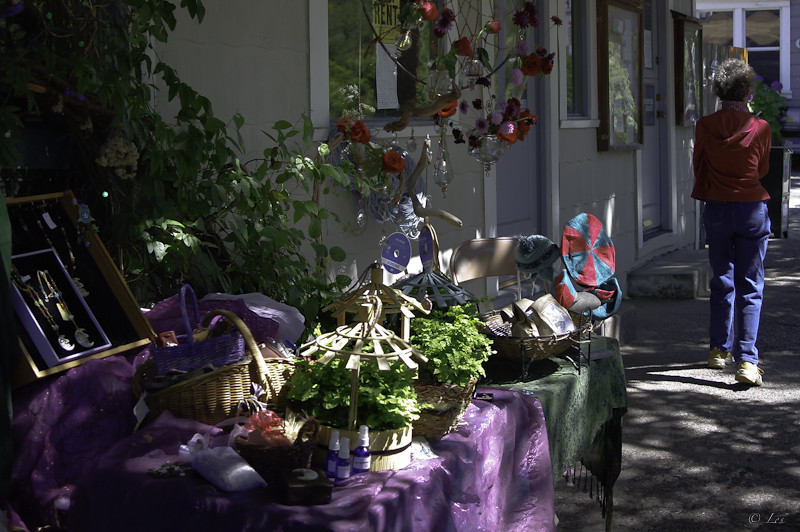
Pentax
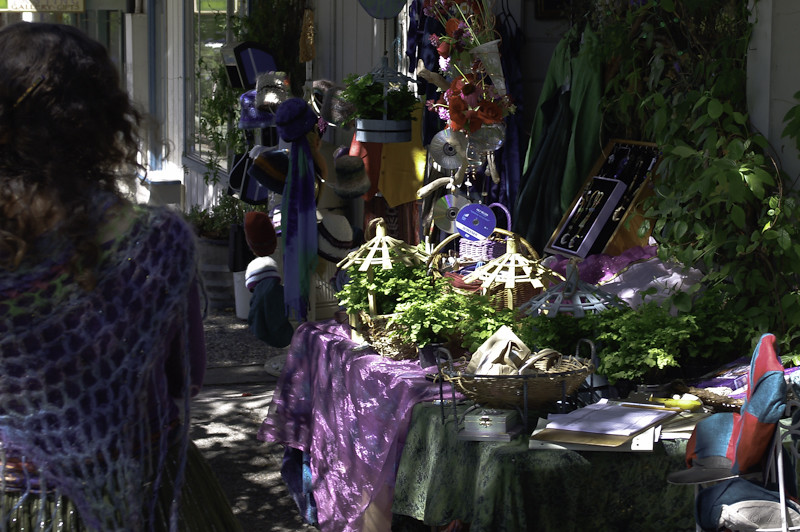
Vivid colors for sure from both lenses.
For the next shots I took the lenses to a remote area, down a lonely one-lane road near the Pacific. All I can say is, the three or so families who live here must love indefatigable wind and being swallowed by fog every day, what a blustery place!
Zeiss

Pentax
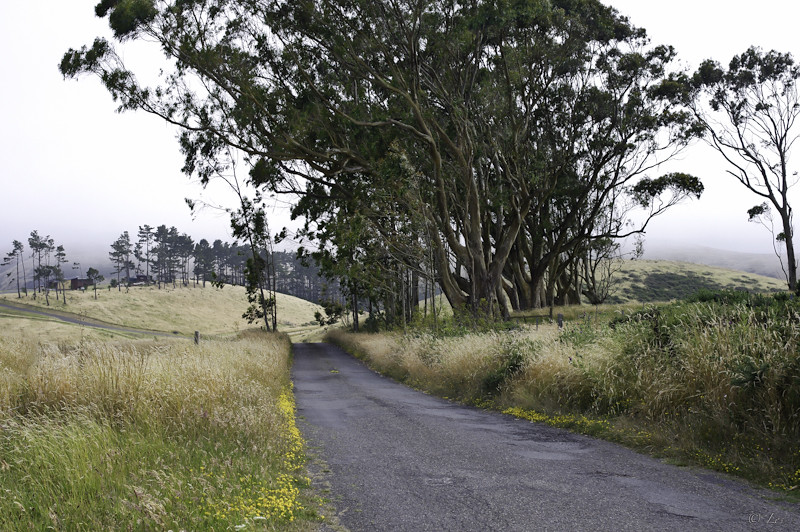
Again, much similarity. However, the asphalt road in the foreground gives a hint of divergence in how the lenses render, with the Pentax leaning toward blue while Zeiss translates it warmer. Yet I hadn’t noticed that in the lily or tie dye shop pictures, why was it showing here? *(See edit comment at the end of this post.)
Other differences in the remote coastal scene were that colors and dynamic range were more muted than the environs of lilies and tie dye shop. On a hunch I reversed direction for my next test, shooting at midday in the vineyard here to see how the lenses performed in a situation of higher dynamic range:
Zeiss
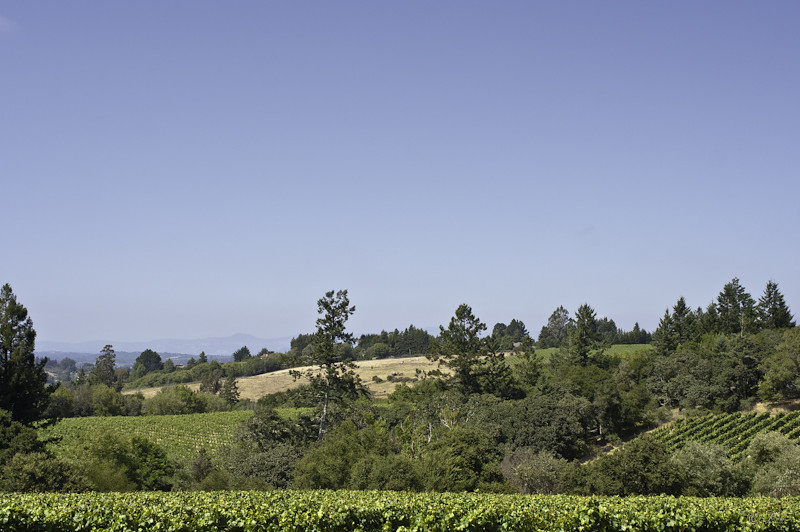
Pentax
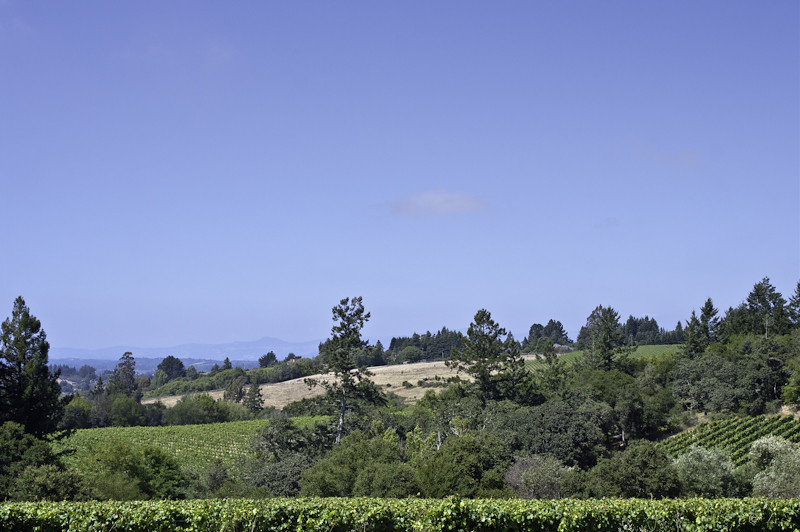
This time the difference was very clear, the Pentax definitely rendered cooler than the Zeiss; also, the Pentax was more contrasty, aided I’m sure by it’s cooler temperament, and that made detail jump out slightly more than with the Zeiss. On the other hand, more variation in color shows from the Zeiss’s warmer portrayal. And looking at them individually (i.e., not in comparison), it didn’t seem either needed much of anything to be an excellent picture (at least that couldn’t be adjusted to taste in post processing).
I decided to try lower dynamic range:
Zeiss

Pentax
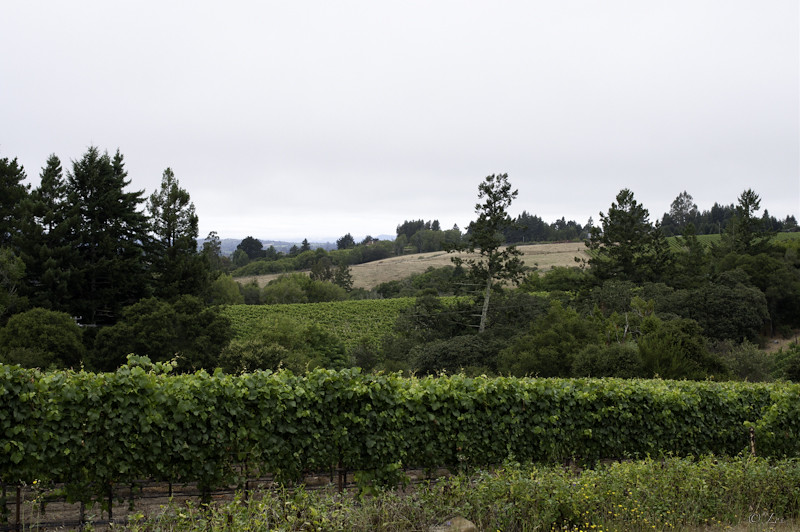
Here the cool-warm differences in rendering again show themselves, with the Pentax’s contrast causing a bit more “pop” and the Zeiss warmth showing more variation in color. Looking at full pictures from each lens you might think that if pixel peeped the Pentax would exhibit noticeably more detail, but that is not easily observed; extreme crops show detail in both pictures are close, with the Pentax perhaps winning by a nose:
Zeiss
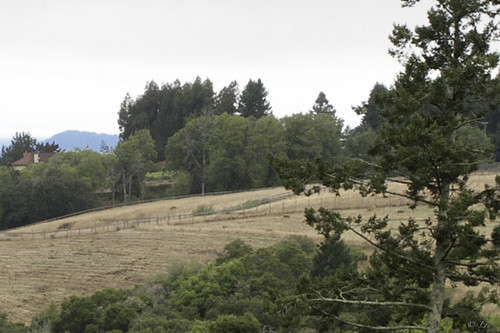
Pentax
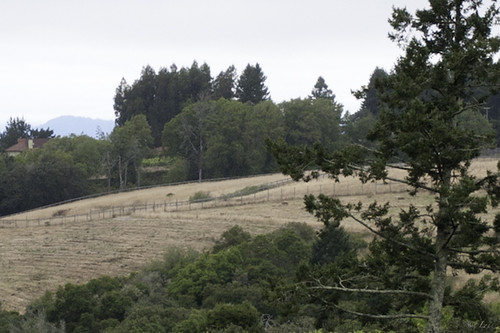
Apparently the detail was manifested by both lenses, but made more noticeable by the cooler and higher contrast rendering of the Pentax. *(See edit comment #3 at the end of this post for how white balance setting might be what accounts for temperature differences.) To test for more absolute resolution profiles, I shot a plank wall where the results would be easier to study and then compared center and corners:
Full wall

Zeiss upper left corner crop

Pentax upper left corner crop
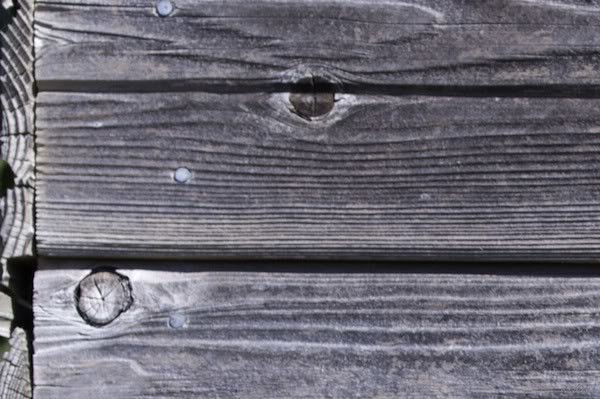
Zeiss lower right corner crop
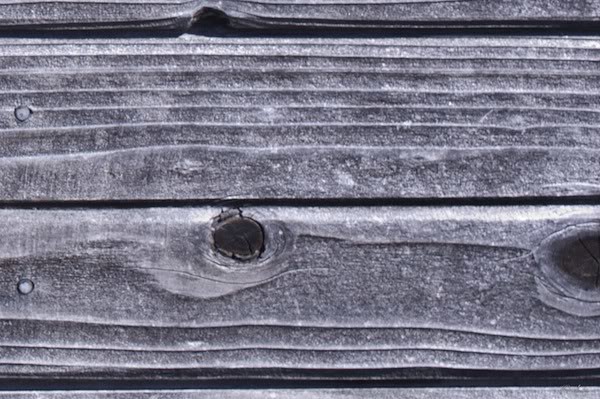
Pentax lower right corner crop
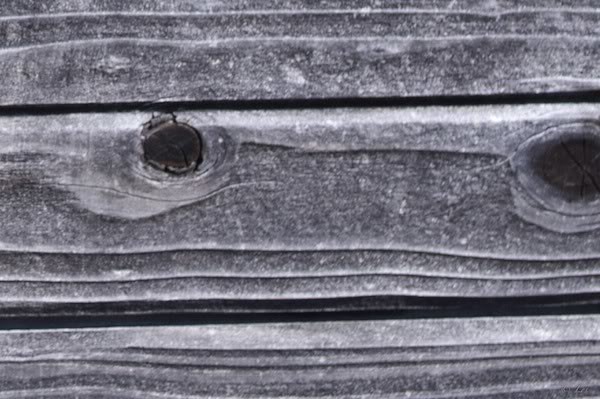
Zeiss center crop
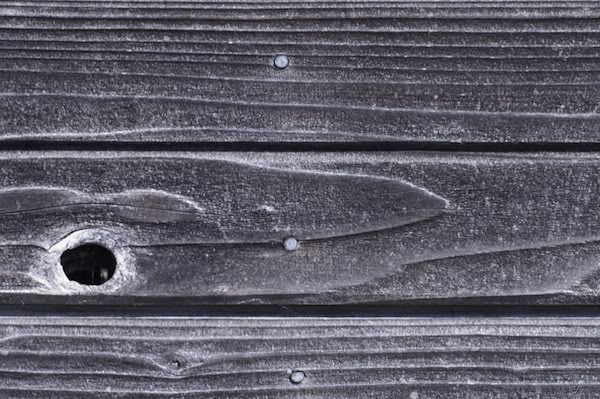
Pentax center crop

These shots indicate the Zeiss is somewhat better in the corners, and the Pentax does a little better in the center*; when pixel peeping all the other photos taken for this shootout, I thought that generally seemed to hold true. My take on this was that that both lenses exhibit superb resolution, but show it differently in high and low dynamic range conditions. *(See edit comment at the end of this post.)
Next up a chromatic aberration test, which I did by simply pointing at branches in front of the sun; here is the full shot using the Pentax lens:
Pentax full shot
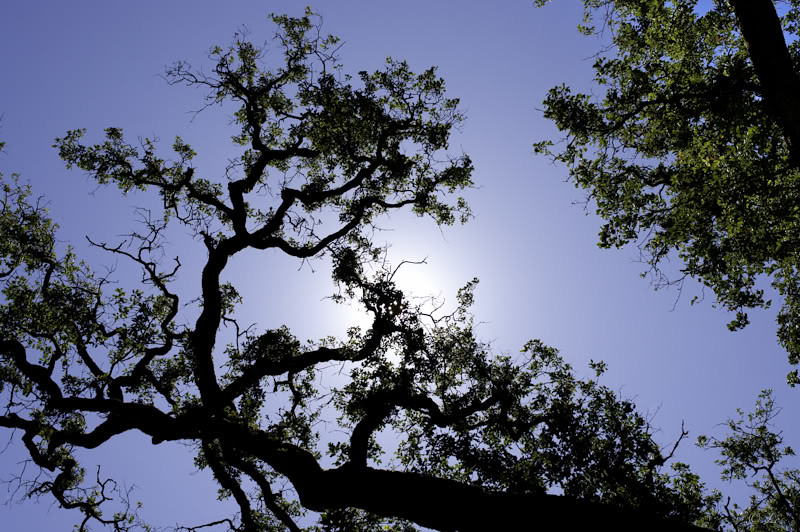
Zeiss crop

Pentax crop
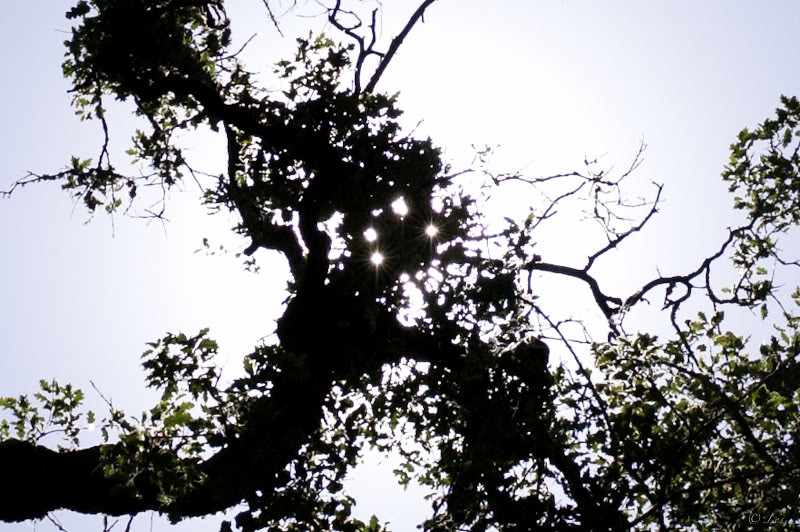
The Zeiss was impressive in this test, I don’t think it shows a bit of CA; the Pentax didn’t fare so well viewed super close, but looking at the full shot of the branches taken by Pentax (the first pic) one can see the CA isn’t the least bit noticeable.
Final Thoughts
The lenses very much seem in the same league. The Zeiss seems to yield more uniform resolution, while the Pentax sharpens up the center a tad more. Based on just one test, the Zeiss may be extraordinarily CA resistant, but the Pentax is not faulted by professional reviewers in this regard, so I’m inclined to think the Pentax is good enough, and the Zeiss is exceptional beyond what is noticeable except in extreme crops. And bokeh . . . well, no test for that because I rely on longer focal lengths when I want that, but the Pentax’s 1.8 speed offers more potential for bokeh and low light shooting as well.
In terms of build, they are both all metal, with a great feel. For me the Pentax takes the prize for aesthetics, it is beautiful -- the Zeiss is a bit plain looking (though up close it is clearly a quality lens). I like the dampening of the focus ring on the Zeiss better, more resistance and so less likely to unintentionally move. But then, one must manually adjust aperture with the Zeiss, a slight inconvenience if you’ve not done that. Those of us who grew up with manual focus and aperture adjustment will likely find it less of an issue. The Zeiss is about half the weight, and significantly smaller than the Pentax . . . that’s something I really like; yet the Pentax’s heft felt nice in the hand while using it:
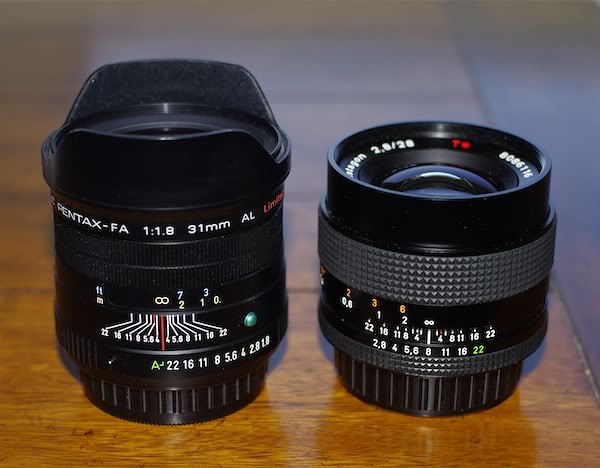
One last consideration is having to buy the Leitax adapter from here, and then install it. It might seem intimidating, but it is actually very simple, taking me 15 extremely careful, triple-checking, reviewing-instructions minutes because I was worrying about doing something wrong (if I did it again I could easily finish in 5 minutes). Remove the screws, pull off the mount, which consists of three pieces, and then put on the single-piece new mount:

There’s a little spring one is warned about at the Leitax site, but you only have to be concerned about it if you are going to restore the old mount; otherwise, you can ruin the spring and throw away the old parts, they serve no purpose for a Pentax camera.
However, there is one significant danger when the screws are to be removed. Make sure to have a very small, sharp-ridged screw driver, and make sure to press very firmly and turn slowly when removing the screws to ensure the screw is actually turning and not being stripped. On mine three of the four screws came out fine, but one stripped because I was careless about applying pressure (I finally got it out though).
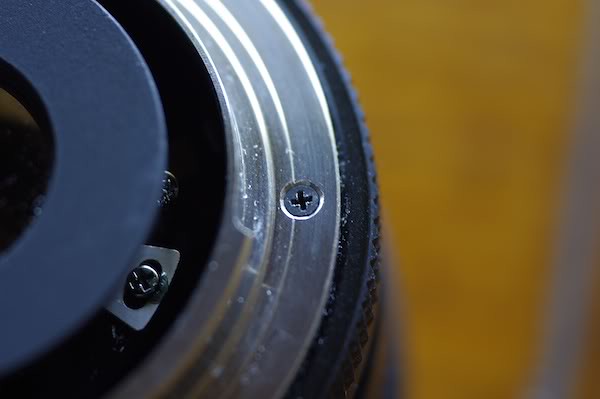
The good news is that two screws are among the unneeded old parts, and they can be used if one ruins a mount screw. I’d suggest disassembling and reassembling on something like a white pillow case because the little ball bearing is easily lost. Not a real problem though since a spare ball bearing is included by Leitax (unless you lose that one too). Also, if you don’t have some, buy the silicon lubricant Leitax offers; it is used to keep the little ball bearing in place during reassembly, plus after I reassembled the lens, the aperture ring worked far more smoothly than it had before applying the lubricant. Finally, I chose the UPS shipping option at Leitax after reading their warning that the adaptor can take weeks to arrive from Spain via the US postal service (apparently security checks can hold it up). It costs an extra $15 for UPS Express, but I got my adaptor in 2 days!
So, who wins the shootout? To me the Zeiss wins because the Pentax FA31 Limited was already a recognized winner (yes, it’s like a communist contest, no losers). The fact that a Limited-quality prime is available at the true normal spot, at half the price of the FA31, makes everyone lusting for a 28mm lens potential winners too. The testing procedure really made me thrilled to own the Zeiss, and gave me confidence that it will perform like a champion when it’s at work on my camera.
Edit Note #1:
I am a little disappointed with how some of the pictures appear here. Looking at the RAW files you can better see, for instance, that the center plank board pictures are slightly better resolved by the FA31, and also that extreme crop of the dirt area of the vineyard in lower DR also is slightly better resolved. But here I don't think it really shows.
The lonely road shots in RAW files are similar in every way except the road; yet here the grass looks quite a bit warmer in the Zeiss rendition.
I don't know how to fix the discrepancy . . . I suppose everyone will have to take my word for it on the lenses' resolving strengths/weakness and handling of DR, or acquire the two lenses and see for themselves! :lol:
Edit Note #2:
Taurus9 writes - "Because the lens is made in Japan, the screws are JIS type, not phillips. So, I would recommend buying JIS drivers, and not attempt to unscrew using regular philips drivers or jewellers screwdrivers. On my copy of the Zeiss 28mm 2.8, the screws were glued down, and required heating from a soldering iron to loosen up."
Edit Note #3:
As a couple of people have pointed out in subsequent posts, that I relied on the auto white balance setting could account for some of the temperature differences in the way each lens rendered color. If so, then what I said about the lens leaning toward blue or red is suspect. Another possibility mentioned for what caused the temperature differences is the lenses coatings, and that seems plausible as well. However, in the end, the cause(s) doesn't matter much to the thread's question of whether the Zeiss is a peer (at least optically) of the esteemed FA31 -- what matters is if the Zeiss can be trusted IQ-wise as a substitute for the FA31.
Edit Note #4, July 16, 2017:
Since Adam briefly turned off the editing time limit so I could fix missing photos, I wanted to add that two Contax lenses I've since Leitaxed (another 28mm and the 50mm) did not focus at infinity. Here's a link to someone on Youtube demonstrating how to adjust lenses for that:
You Tube
|
src="https://www.youtube.com/embed/cWx_28nw_YU?controls=1" allowfullscreen>
|
|











